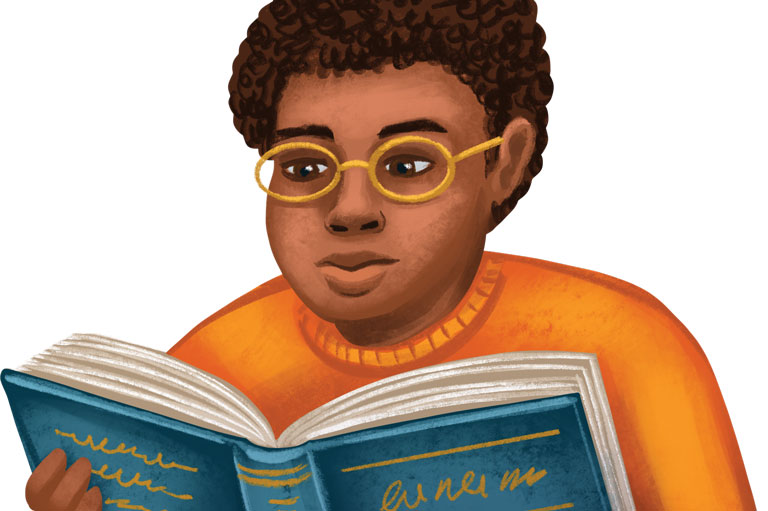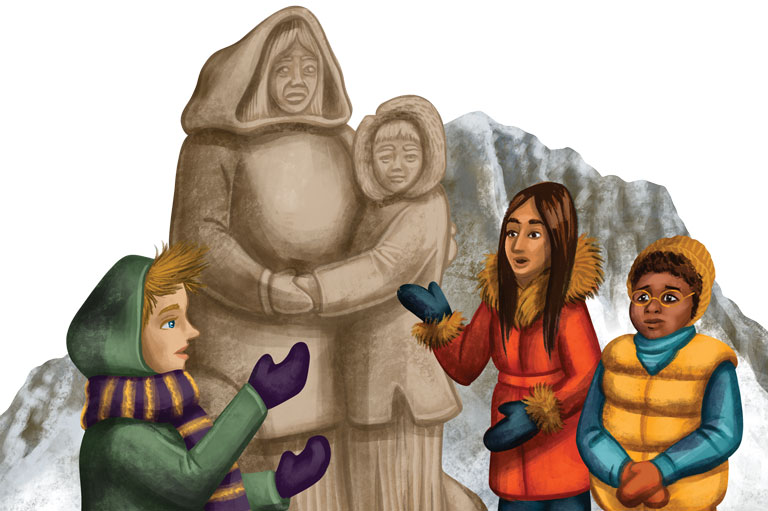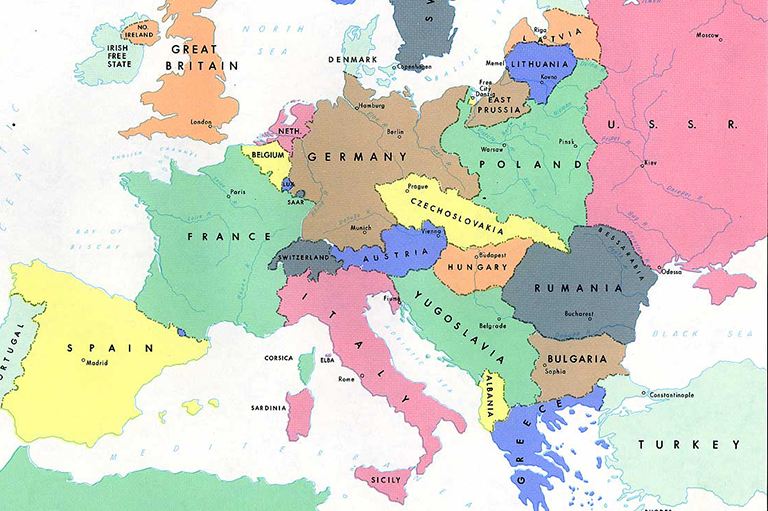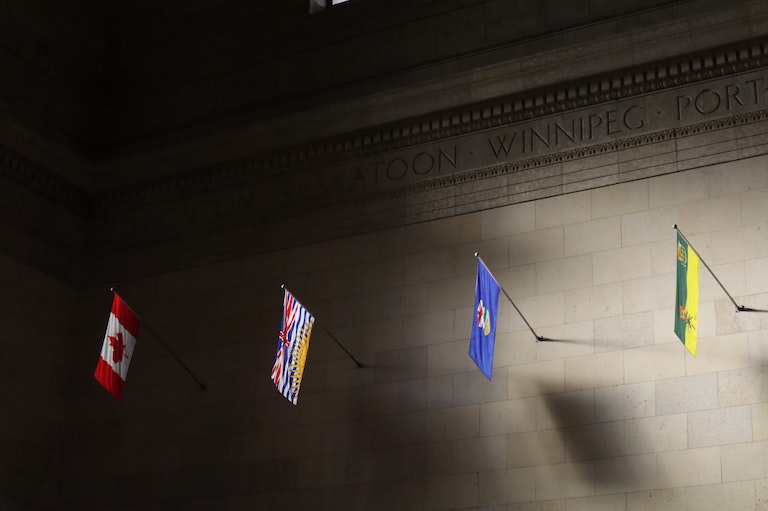Discover a wealth of interesting, entertaining and informative stories in each issue, delivered to you six times per year.
Walking on the Lands of Our Ancestors
Grade Levels: 9/10, 11/12
Subject Area: First Nations, Métis and Inuit, Social Studies, History, Language Arts, Art, Social Justice
Lesson Overview
The following module consists of learning material that is delivered through an Indigenous pedagogical approach. There is extensive context-setting in the form of introductory activities (talking circles, guest speakers, a field-trip to a museum) to front-load the main activity, which is literally, walking (and learning) on the lands of Indigenous people’s ancestors. The location of this “learning on the land” is situated in the Victoria School District, British Columbia, but the module can be applied in any territory in Canada provided proper protocols with respect to working with the Indigenous nation on whose land the school is situated, are established first. Anne Tenning models how teachers can use an Indigenous approach to teaching social studies. A possible outcome in so-doing, is that other disciplinary inquiries may be addressed simultaneously. Ms. Tenning also uses “real life” examples to illustrate how deeply students are impacted by Indigenous guest speakers, and she uses student testimonials as evidence. Ms. Tenning uses a first person narrative to explain how she conducts her classes.
Time Required
The module contains material that can be used in anywhere from 5 double periods (1:40 x 5 = one week) to 20 double periods (1:40 x 25 = one month), depending on the length of time that is needed for a particular learner group and how in-depth the teacher wants to go.
Historical Thinking Concepts
This lesson plan uses all six historical thinking concepts. This includes: establish historical significance, use primary source evidence, identify continuity and change, analyze cause and consequence, take historical perspectives, and understand the ethical dimension of historical interpretations.
Learning Outcomes
Student will:
- Summarize what they learned about local Indigenous culture, knowledge, and history.
- Participate in activities that use traditional Indigenous teaching techniques.
- Evaluate the effectiveness of traditional Indigenous teaching techniques and compare to the contemporary education system.
- Describe connections they made between how the past connects to the present and future.
Background Information
Prior to European contact, the Original Peoples of Canada had societies that were unique in every way. For example, First Nations people had their own forms of governance, health care, spirituality, resource use, social structures, and education. Children were regarded as gifts from the Creator and they were treated with the utmost love and respect. Traditional education from Indigenous people’s cultural groups all across Canada had these qualities in common:
- Children would be taught by many different members of their family and community.
- Learning was hands-on, experiential, and took place out in the environment or within First Nations cultural practices (such as the potlatch or longhouse systems on the west coast).
- Learning was lifelong and started at birth and ended at death.
- Children were the students and also the teachers: adults and elders could also learn from the wisdom of children.
- Children learned by watching and doing, but they also learned independently through coming of age ceremonies and by spending time alone.
- Children learned through an oral culture, where knowledge was passed down verbally through stories, songs, dances, and artistic representations.
- The education of Indigenous children was holistic and children learned how everything was interconnected; everything had a spiritual connection.
- At the core of traditional education was the value of respect: respect for oneself, for others, for the Creator, for the environment, for the ancestors, and for the generations to come in the future.
After the eras of first contact and the fur trade, the era of colonialism saw policies of Assimilation enforced by the Canadian government with the goal of assimilating Indigenous people into the European-based Canadian culture. The tools of assimilation were mandated through the Indian Act, a set of laws that applied just to the First Nations people of Canada (currently, there are 3 recognized groups of Indigenous peoples in Canada recognized as Indigenous or Indigenous: First Nations, Metis, and Inuit). Mandatory residential school education, cultural bans, and resource-use restrictions were enforced through the Indian Act.
First Nations people were moved onto restrictive reserves and they were considered wards of the government. First Nations people were not regarded as Canadian citizens and given the right to vote provincially in British Columbia until 1949 and federally until 1960. The potlatch ban was not removed from the Indian Act until 1951, the same year that First Nations people were given permission for the first time to attend public schools.
The most damaging of assimilation policies was the residential school system, a system that was contradictory to traditional First Nations teaching practices in every way. First Nations children were removed from their families and communities and taken away to industrial schools where they were forced to live year round and adopt a European-based culture and religion. In some cases, children were permitted to return home during holidays or the summer. But this did not make up for the trauma children experienced by being denied a normal childhood with their parents and families. Instead, they spent their childhoods in residential schools located far from home, where abuse, neglect, and strict regimentation were commonplace. It is only now that residential school survivors are starting to receive compensation from the Canadian government and religious institutions for the abuse they suffered at these schools. In B.C. the last residential school did not close until 1984. The after-effects of residential schools continue to impact Indigenous people and communities today.
It is important that these aspects of Canadian history are addressed in our Social Studies classes so that all students have an understanding of the lasting impacts of colonialism on Indigenous peoples. Canada is a relatively young country, and students should be knowledgeable about the people and cultures that were here first. Our contemporary education system is still modeled on European culture, but all students can benefit by learning about and experiencing traditional Indigenous teaching practices. Teachers do not need to be Indigenous to incorporate Indigenous knowledge , culture, and history into their classes. In order to understand contemporary Indigenous issues, we must first examine how these issues are rooted in the past. Issues such as treaties, land claims, residential school compensation, healthcare, and education, just to name a few, are important to all Canadians, both Indigenous and non-Indigenous. A perfect place to learn about and bring greater awareness to these issues is in our classrooms.
The Lesson Activity
Activating through “front-loading”:
Introductory Activities
There are several activities that teachers can do in their classrooms to familiarize students with traditional Aboriginal teaching techniques and protocols. Once students have a foundation of knowledge, going on a hike to learn about local First Nations culture and history will have more meaning.
Introductory Activity One - Talking Circles
Talking circles are a traditional form of communication common to many different First Nations cultural groups. I use talking circles in the classroom so that students can experience this form of the oral culture. Tips for using a talking circle include:
- Try to use a talking circle in your class once a week and whenever you have a First Nations guest speaker (to do introductions).
- Use an item that is special to you or the students (a feather, rock, stick, shell, etc.).
- Only the person with the shell (or whatever you use) can talk – everyone else listens.
- It is good to hear from everyone in the circle, but everyone has the right to pass.
- No one is to leave during a circle.
- If using the talking circle in the classroom, lock the doors and put a “circle in progress” sign on the doors so you do not get interrupted by latecomers; unlock the doors once the circle is finished.
- Whatever is shared in the circle stays in the circle.
- Use “I” statements; no discussion about what people share.
- Teachers, start by introducing yourself: your name and where you are from Sometimes people will also share who their family is.
- In very formal circles, people stand when it is their turn to speak.
- Share a little about yourself: how you are doing, something you are looking forward to, what is going on in your life, or share opinions if the circle is addressing a particular topic/issue.
- Pass the talking circle object on to the students and they will each contribute to the circle in the same way, or say “pass.”
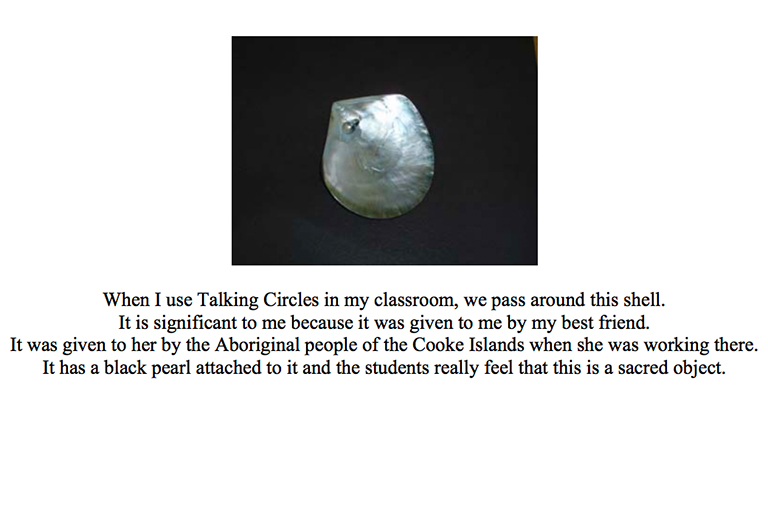
Introductory Activity Two - Guest Speakers
Traditionally, youth were taught by many members of the community. Though I teach most of the course myself, I also invite several guest speakers into my class so that students can experience this aspect of the traditional Indigenous education. Guest speakers bring the topics you are learning about in your class to life. Suddenly, course content becomes real and enriched with emotion. I invite guest speakers to come into my class to talk about many topics, including the Indian Act, residential schools, Métis culture and history, and the BC treaty process. I have included student feedback from just two of the guest speakers who have come into our class. Before you invite in an Indigenous guest speaker, there are some general tips and protocols to keep in mind:
- Discuss time frame and content with your guest.
- Arrange for you school or school district to send a monetary honourarium to your guest speaker.
- Make sure he/she is comfortable with the topic.
- Ask your guest if it is okay for you to take pictures.
- Ask guest for background info you can use to introduce him/her.
- Contact your guest a day or two before the presentation to make sure the presentation is “still a go.”
- Prepare your class: go over respectful behaviour, brainstorm questions, remind the class to take notes.
- Arrange to meet your guest before class starts at a location that is easy for the guest to find (like the main office).
- Does your guest need handouts photocopied or any other preparations? • Let your guest know where the restrooms are.
- Offer the guest something to drink and eat.
- The teacher or a student introduces the guest and the topic of the presentation.
- Class introductions: teacher starts and then the students introduce themselves (use the circle format).
- Guest then introduces him/herself and then proceeds with the presentation.
- Leave sufficient time for the students to ask questions and for closure.
- The teacher or a student thanks the guest and presents the guest with a gift
- Time-permitting, each student could thank the guest using the circle format
- Offer to walk the guest out; does he/she have any questions? Let your guest know that the honourarium will be mailed out.
- Discuss/debrief the presentation at the next class.
- Students should fill out a journal entry based on the presentation; the journal entry should include a summary of what the guest speaker spoke about, what information from the presentation stood out to the students, what the student learned, and opinions, ideas, or connections that the student made as a result of the presentation.
- All students should sign a thank-you card; mail the card and a picture from the presentation to the guest
Explore the details of Ms. Tenning's Guest Speaker visits.
Introductory Activity Three - Field Trip to the Museum
At the beginning of First Nations Studies 12, the students learn about pre-contact Indigenous societies, followed by a unit on first contact and the fur trade. Much of this content is learned through lectures, videos, and the BC First Nations Studies 12 textbook. At this point in the course, I take students on a field trip to the Royal BC Museum where they can see many of the topics we have been talking about on display at the Museum.
Our field trip is facilitated by Leslie McGarry, an Indigenous woman who has an immense amount of firsthand knowledge about the First Peoples exhibit in the museum. We start the field trip in the Mungo Martin Longhouse and Leslie teaches the class about the function of the longhouse in coastal Indigenous cultures and also the purposes of potlatch ceremonies.
Going to the museum is a part of traditional, experiential learning. By hearing stories and firsthand knowledge about the artifacts, the history we are learning about in class becomes a lot more real. A field trip like this is beneficial to all kinds of learners, including visual, auditory, and tactile. After the field trip, students complete a journal entry very similar to the kind they would write after a guest speaker’s presentation.
Acquiring (through completion of the central activity):
Central Activity: Walking on the Lands of our Ancestors
An essential component to teaching about First Nations culture, knowledge and history is to take your class on a field trip to a local First Nations territory. This kind of activity works best once the students have had an opportunity to:
- Learn about the local history, including pre-contact First Nations society, first contact with explorers and fur traders, and colonialism.
- Experience traditional First Nations teaching techniques, such as talking circles, guest speakers, and experiential learning
Taking your students out to a local traditional territory requires a lot of planning and the adherence to certain protocols. If you are not from the local First Nations territory, it is proper protocol to ask someone from that territory to facilitate your trip. Your facilitator can check with the local community and people to make sure that it is okay for your class to visit their lands.
Even though I am a First Nations person, I am not from the local territory where I teach in Victoria. I am from the Chemainus First Nation, so I asked Mark Albany, a First Nation’s counsellor in our school district, and also a member of one of the local territories, to facilitate our field trip to some of the traditional sights in the Victoria area. Jim Young, Education Liaison with the Victoria Native Friendship Centre, co-facilitated the field trip with Mark Albany. Before we went on the field trip, Mark and Jim came in to speak to my class to tell the students how to prepare for the field trip (what to wear, what to bring, etc.) and also to let the class know what the ground rules were. This is an all day field trip, so field trip permission forms need to be filled out and transportation organized.
Location #1 - Craigflower Creek
We started our field trip in a wooded area that is a part of Thetis Lake Park. We hiked along the trails in the park for over two hours, where we learned about traditional First Nations plant uses and where we also got to see evidence of a traditional First Nations village site. Some of the evidence that we saw included culturally modified trees (CMT’s) and middens, which are areas of soil that include evidence of the people who used to live there.
Society Location #2 – Craigflower School and the Gorge Waterway
At the second location of our field trip, we went to look at evidence of Aboriginal village sites in the urban, Victoria setting. First, we went to a spot beside the original Craigflower Elementary School to look at middens and then we went to a location under a bridge by the Gorge Waterway to look at another ancient midden site and to hear a creation story from that area. It was fascinating to see cultural evidence so close to the city.
Location #3 – Downtown Victoria; the Inner Harbour
The last location of our field trip was in the heart of downtown Victoria at the Inner Harbour. Here, we learned that the Songhees people originally lived in the area right where we were standing, but in 1911, the Songhees people were moved by the government away from downtown to the site where their reserve is still located today, on the outskirts of Victoria. Two totem poles stand at the location of the original village site to commemorate this history. This part of the trip really brought to life the displacement many Indigenous communities experienced as a result of settlement and colonial policies.
Applying:
Students will demonstrate their understanding through telling how they were impacted by participating in the various activities. They do this through journal-writing.
Concluding Activity
After our field trip to some of the local, traditional First Nations village sites, the students are asked to complete a reflective journal to summarize what they learned from this experience. Journal writing is an ideal assessment tool when teaching about Indigenous content and using traditional Aboriginal teaching strategies because it allows the students to respond to the learning activities personally. The students, in essence, can become the authors of their learning. Journal writing allows for freedom of expression and creativity.
Assignment
Please complete a reflective journal entry based on your experience during this field trip. Your journal entry should include:
- A summary
- summarize the field trip – the date, where we went, what we did, who the facilitators were, why we went on this field trip, etc.
- What you learned:
- about the local sites; First Nations culture, knowledge, and history, etc.
- A personal reflection: some ideas …
- What did you enjoy or find interesting about this field trip?
- Are field trips like this valuable?
- Did you make any connections between how the past connects to the present or the future?
- What are your thoughts about experiencing traditional Indigenous teaching techniques?
Your journal should include an element of creativity. Some ideas: you could include one of the following: photos that you took during the field trip, drawings inspired by the trip, images that are symbolic of what you learned, a poem based on your experience on this trip, or objects that represent the field trip.
Format
- A written journal entry: length – will vary; must include the elements listed above, or
- an oral presentation: you could share with the class your thoughts on the elements listed above and share your photos, pictures, objects, or poem
Your journal entry or presentation will be assessed based on the criteria outlined above.


